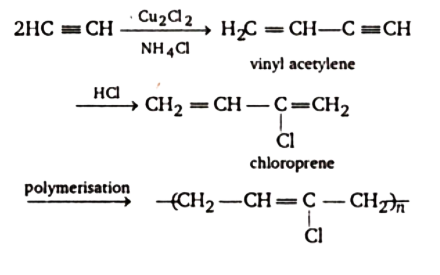
Catalyst used in dimerisation of acetylene to prepare chloroprene is
A . HgSO4 + H2SO4
B . Cu2Cl2
C . Cu2Cl2 + NH4Cl
D . Cu2Cl2 + NH4OH
Answer
332.7k+ views
Hint: In this question we have to use the reaction of dimerisation of acetylene to prepare chloroprene to find out the catalyst used in this reaction. Dimerization is the process by which two molecules with comparable chemical make-up combine to produce a single polymer called a dimer.
Complete Step by Step Answer:
When acetylene reacts with hydrogen chloride to create 4-chloro-1, 2-butadiene, an allene derivative, it dimerizes to produce vinyl acetylene. In the presence of cuprous chloride(Cu2Cl2) and ammonium chloride(NH4Cl), this derivative rearranges to produce 2-Chlorobuta-1, 3-diene.
There are two phases in the conventional synthesis of chloroprene. Acetylene is first dimerized to vinylacetylene in a reaction tower at 80 °C in an aqueous hydro-chloric acid solution of Cu2Cl2 and NH4Cl.
Water evaporation regulates the significant evolution of heat. The conversion of C2H2 is around 18%. The major by-product is divinylacetylene, and the selectivity to vinylacetylene can reach 90%. In the second stage HCl is added to vinylacetylene, forming chloropropene.

The correct answer is option (C) Cu2Cl2 + NH4Cl.
Additional Information: A catalyst is a substance that, without being consumed by the process, speeds up a chemical reaction or lowers the temperature or pressure required to initiate one. The addition of a catalyst to a reaction is known as catalysis. By lowering the activation energy, the energy barrier that must be cleared for a chemical reaction to take place, catalysts increase the efficiency of a reaction. There will be two steps in the conversion of acetylene to chloroprene. A triple bond and two carbon atoms are both present in the organic molecule acetylene. Four carbon atoms make up the chemical chloroprene, which also contains a chlorine atom in the second position. There are double bonds in the first and third positions.
Note: A triple bond and two carbon atoms are both present in the organic molecule acetylene. Four carbon atoms make up the chemical chloroprene, which also contains a chlorine atom in the second position. There will be two processes required to transform acetylene into chloroprene.
Complete Step by Step Answer:
When acetylene reacts with hydrogen chloride to create 4-chloro-1, 2-butadiene, an allene derivative, it dimerizes to produce vinyl acetylene. In the presence of cuprous chloride(Cu2Cl2) and ammonium chloride(NH4Cl), this derivative rearranges to produce 2-Chlorobuta-1, 3-diene.
There are two phases in the conventional synthesis of chloroprene. Acetylene is first dimerized to vinylacetylene in a reaction tower at 80 °C in an aqueous hydro-chloric acid solution of Cu2Cl2 and NH4Cl.
Water evaporation regulates the significant evolution of heat. The conversion of C2H2 is around 18%. The major by-product is divinylacetylene, and the selectivity to vinylacetylene can reach 90%. In the second stage HCl is added to vinylacetylene, forming chloropropene.

The correct answer is option (C) Cu2Cl2 + NH4Cl.
Additional Information: A catalyst is a substance that, without being consumed by the process, speeds up a chemical reaction or lowers the temperature or pressure required to initiate one. The addition of a catalyst to a reaction is known as catalysis. By lowering the activation energy, the energy barrier that must be cleared for a chemical reaction to take place, catalysts increase the efficiency of a reaction. There will be two steps in the conversion of acetylene to chloroprene. A triple bond and two carbon atoms are both present in the organic molecule acetylene. Four carbon atoms make up the chemical chloroprene, which also contains a chlorine atom in the second position. There are double bonds in the first and third positions.
Note: A triple bond and two carbon atoms are both present in the organic molecule acetylene. Four carbon atoms make up the chemical chloroprene, which also contains a chlorine atom in the second position. There will be two processes required to transform acetylene into chloroprene.
Recently Updated Pages
Master Class 11 Economics: Engaging Questions & Answers for Success

Master Class 11 English: Engaging Questions & Answers for Success

Master Class 11 Social Science: Engaging Questions & Answers for Success

Master Class 11 Biology: Engaging Questions & Answers for Success

Class 11 Question and Answer - Your Ultimate Solutions Guide

Master Class 11 Business Studies: Engaging Questions & Answers for Success

Trending doubts
What is BLO What is the full form of BLO class 8 social science CBSE

What is meant by exothermic and endothermic reactions class 11 chemistry CBSE

Which places in India experience sunrise first and class 9 social science CBSE

The shortest day of the year in India

What are the major means of transport Explain each class 12 social science CBSE

Which are the Top 10 Largest Countries of the World?




